The Monarch Butterfly Timeline: Life Cycle Insights
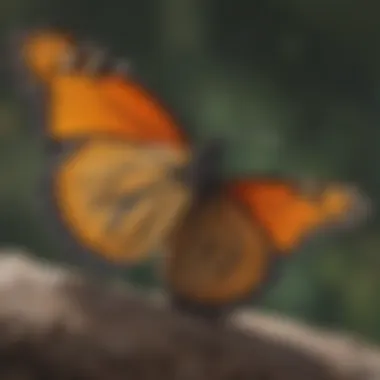

Nature Topic Overview
Monarch butterflies are remarkable creatures, known for their stunning orange and black wings. Their life cycle undergoes distinct phases, each with its own significance. This article will guide you through the timeline of the monarch butterfly, providing a clear understanding of its journey from egg to adult, and eventually, its impressive migration. As we explore their life events, it will become clear why these butterflies hold a crucial role in our ecosystem. They not only serve as pollinators but also highlight the importance of conservation efforts.
Fun Facts and Trivia
Engaging young readers can be easier with fun facts about monarch butterflies. Here are some that might spark their interest:
- Life Span: Monarchs typically live 4-6 weeks, but the final generation can live up to 8 months.
- Migration Distance: Some migrate over 3,000 miles from North America to central Mexico.
- Chemical Defense: They become unpalatable to predators by feeding on milkweed as larvae.
These facts can be supported with visuals like images of butterflies at different stages, maps of migration routes, and maybe even interactive quizzes to test their knowledge!
Wildlife Explorations
The monarch butterfly is not alone in its habitat. Many species share the same environment, each playing a part in the ecosystem. Some related species include:
- Milkweed: The host plant for monarch caterpillars.
- Swallowtail Butterflies: Known for their graceful flight and similar diets.
- Honeybees: Important pollinators that work alongside butterflies.
Quizzes about these species can help reinforce information and engage learners.
Environmental Awareness
Conservation is essential for the survival of monarch butterflies. Various factors threaten their habitats, like pesticide use and climate change. Children can actively participate in conservation efforts with simple actions, such as:
- Planting milkweed and nectar plants to support butterfly populations.
- Reducing pesticide use in gardens.
- Participating in local clean-up events to protect habitats.
Encouraging children to care for their environment helps instill a sense of responsibility and awareness about ecological challenges.
DIY Nature Activities
Hands-on learning is valuable for children. Here are some DIY activities to explore the world of monarch butterflies:
- Butterfly Garden: Create a small garden with milkweed and nectar plants. Guide them through planting, caring for, and observing the butterflies.
- Lifecycle Craft: Make a craft depicting the four stages of the monarch life cycle. This could involve using paper or clay to represent eggs, caterpillars, chrysalises, and adults.
- Nature Walks: Organize simple walks in local parks to observe butterflies. Provide worksheets for children to document their findings.
By conducting these activities, children can deepen their understanding of nature while having fun.
Preface to Monarch Butterflies
The study of monarch butterflies is essential for understanding their role in nature. Monarchs are astonishing insects known not only for their vibrant orange and black wings but also for their complex life cycle and migratory behavior. This section aims to introduce readers to the key elements that make monarch butterflies significant.
Overview of Monarch Butterflies
Monarch butterflies, scientifically named Danaus plexippus, are a remarkable species found primarily in North America. They are easily recognized by their striking coloration, which serves as a warning to predators about their toxicity. These butterflies undergo a fascinating life cycle that includes four distinct stages: egg, caterpillar, pupa, and adult butterfly. Each stage has its own unique attributes and challenges.
Monarchs are famous for their long migrations. Every year, they travel thousands of miles from their breeding grounds in Canada and the United States to their wintering sites in Mexico. This incredible journey showcases the resilience and adaptability of monarchs in the face of environmental changes.
Significance in Ecosystems
Monarch butterflies play a vital role in ecosystems. They contribute significantly to pollination, which is essential for the production of various plants, flowers, and crops. As they move from flower to flower in search of nectar, they inadvertently transfer pollen, facilitating plant reproduction. This process is crucial not only for the plants themselves but also for the entire food web that relies on these plants.
Their presence can be an indicator of a healthy environment. A decrease in monarch populations may signal larger issues within ecosystems, such as habitat loss or climate change. Protecting and understanding monarch butterflies can therefore provide insight into the health of our natural world.
"The monarch butterfly's journey is a powerful reminder of the interconnectedness of life."
Monarchs also serve as educational tools for young learners. They inspire curiosity about biology, ecology, and conservation, fostering a deeper appreciation for nature among children aged 5 to 12. In summary, the introduction of monarch butterflies opens various avenues for exploration, from their life cycle to their vital ecological roles.
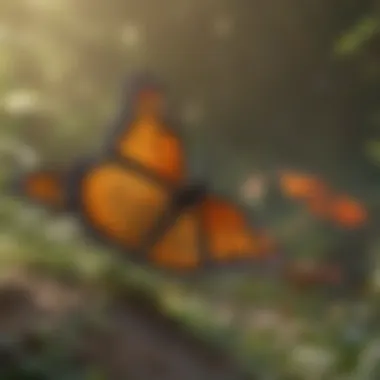
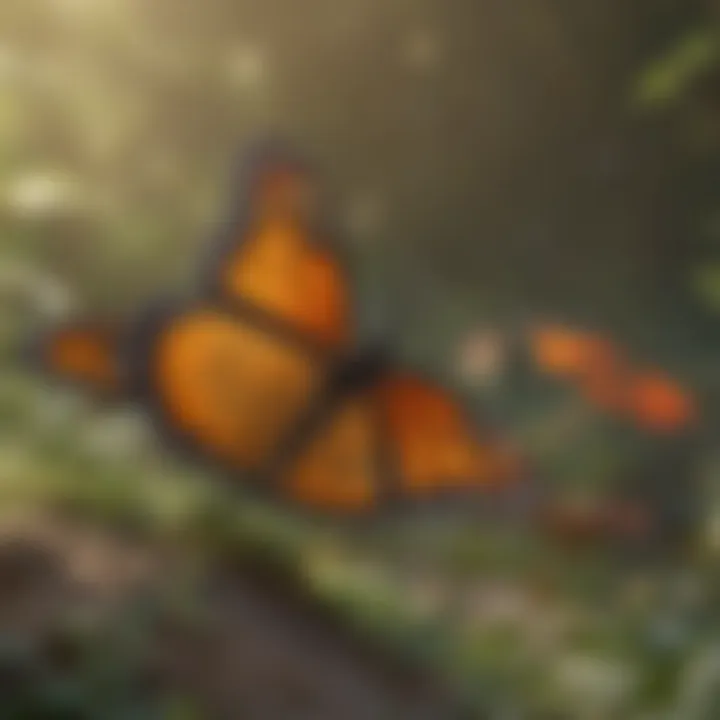
The Life Cycle of Monarch Butterflies
The life cycle of monarch butterflies is a critical aspect of their existence and offers insight into their remarkable journey. Understanding this life cycle is essential because it illustrates how these butterflies grow, reproduce, and survive in diverse environments. This knowledge helps us appreciate their ecological role and the importance of preserving their habitats.
Egg Stage
The life of a monarch butterfly begins as a tiny, round egg. Female monarchs lay their eggs on the undersides of milkweed leaves, which is crucial. Milkweed is the only plant that caterpillars eat. The eggs are small, about the size of a pinhead, and are creamy white when first laid. In about three to ten days, the eggs hatch, and the caterpillars emerge. This initial stage is critical for the survival of the species as it ensures a food source for the caterpillars once they hatch.
Caterpillar Stage
Once the eggs hatch, the caterpillars, also known as larvae, begin to eat voraciously. They consume milkweed leaves, growing rapidly as they feed. This stage can last about two weeks. Caterpillars undergo a series of molts, shedding their skin up to five times as they grow. During this stage, they accumulate toxins from the milkweed which makes them distasteful to predators. This survival strategy is a fascinating aspect of their development.
Pupal Stage
After the caterpillar has reached its full size, it is ready to transform into a pupa. This stage is also known as the chrysalis. The caterpillar finds a safe spot, typically on a branch or leaf, and attaches itself using a silk thread. The chrysalis is usually green with gold spots. Inside, the caterpillar undergoes significant changes. This process can take about ten days to two weeks. Upon completion, the chrysalis becomes transparent, revealing beautiful colors in the wings.
Adult Butterfly Stage
Finally, the monarch emerges from the chrysalis as a fully formed butterfly. This adult stage marks the beginning of a new chapter in its life. The butterfly will rest for a few hours to allow its wings to dry and expand. Adult monarchs primarily feed on nectar from flowers, which helps in pollination. They have a life span of around two to six weeks, but those that begin migration can live up to eight months. Adult butterflies are vital for the ecosystem as they assist in pollination and support food chains.
As we observe the life cycle of monarch butterflies, we see a story of growth, survival, and environmental interaction that varies seasonally and geographically.
Important Milestones in Monarch History
The history of monarch butterflies is rich with significant events that have shaped our understanding of this species. These milestones not only detail the scientific exploration of monarchs but also highlight their importance in ecosystems and the challenges they face. Understanding these milestones is crucial for appreciating the journey of monarch butterflies and their role in nature.
Discovery and Naming
The discovery of the monarch butterfly can be traced back to early European explorers who first described these striking insects. The scientific name, Danaus plexippus, was assigned by the Swedish botanist Carl Linnaeus in 1758. Naming the monarch was more than just a label; it marked the beginning of formal recognition in scientific literature. This milestone sparked curiosity among naturalists and entomologists, leading to further studies into the butterfly’s life cycle, habitat, and migratory patterns. The naming of the species signaled the importance of categorization in biology, enabling future research to build on this foundational knowledge.
First Studies and Research
Following their discovery, monarch butterflies became the subject of various studies. In the late 19th and early 20th centuries, scientists began to examine monarchs more closely. Researchers like William Kirby noted their unique migration habits. Early studies focused on understanding their lifecycle and the observable phases from egg to adult butterfly. The scientific community recognized that studying the monarch's lifecycle also revealed important details about their breeding patterns, feeding habits, and the environmental factors essential for their survival.
"Research on monarch butterflies has greatly enhanced our knowledge of insect ecology, offering insights that resonate across multiple fields of study."
Migration Patterns Documented
A defining milestone came with the documentation of monarch migrations. In the 20th century, naturalists discovered that monarchs undertake a remarkable journey from North America to Mexico. This seasonal migration, spanning thousands of miles, astonished researchers and provided deeper insights into the butterfly's behavior. Detailed studies revealed the routes taken and the environmental cues that trigger migration. These findings have encouraged conservation efforts, as understanding migration patterns is essential for protecting the habitats along this vital flyway.
Conservation Efforts Initiated
As awareness grew about the decline in monarch populations, conservation efforts intensified. In the late 20th century, organizations and scientists began to advocate for the protection of monarch habitats. Efforts included planting milkweed, the vital host plant for monarch larvae, and educating the public about the importance of preserving natural landscapes. These initiatives not only aim to safeguard the butterflies but also to maintain the ecological balance within their habitats.
In summary, the important milestones in monarch history are significant not only for what they tell us about the species, but also for the actions they inspire to ensure their continued survival. Understanding these milestones helps raise awareness and encourages actionable steps for conservation.
Migration of Monarch Butterflies
The migration of monarch butterflies is a truly remarkable aspect of their lifecycle. This journey not only showcases their incredible endurance but also highlights the impact of environmental factors on their survival. Monarch butterflies travel thousands of miles, emphasizing the need for awareness of their migratory patterns and the subsequent conservation efforts necessary to protect these amazing insects.
Understanding Migration
Monarch migration occurs in two primary parts: the journey south to warmer climates and the return trip north in spring. This cyclical movement is driven by seasonal changes and food availability. As fall approaches, temperatures drop and milkweed plants, their primary food source, begin to die. This prompts the monarchs to head south toward Mexico, where they can find suitable habitats and food resources. The journey offers not only shelter and nourishment but also facilitates reproduction once they return in spring.
Journey to Mexico
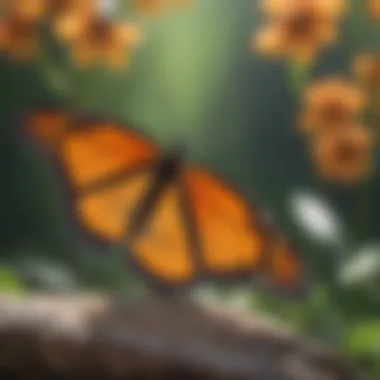

Every year, millions of monarchs embark on this incredible journey to Mexico. They travel approximately 2,500 miles, facing various obstacles along the way. Some butterfly enthusiasts have observed that monarchs use a combination of wind currents and thermal updrafts to assist in their flight. They often make stops to rest and refuel on nectar from flowers. Monarchs will gather in large numbers at specific sites when they reach their destination in central Mexico. Here, they overwinter in oyamel fir forests, where they find protection from the cold weather.
Return Migration
As the days grow longer and temperatures warm in spring, the monarchs begin their return migration north. This journey is just as crucial as the journey south because they need to find milkweed to lay their eggs. The return trip occurs over several generations. The first group that migrates back does not make it all the way to their original home. Instead, they lay eggs, and the subsequent generations continue the journey northward. This process can take several months, and by the time they reach the northern United States or Canada, they will have completed a remarkable life cycle.
"The migration of monarch butterflies reflects significant ecological patterns and needs for ongoing conservation efforts."
The migratory habits of monarch butterflies serve as essential indicators of the health of our ecosystems. To protect these valuable creatures, awareness and conservation strategies are necessary.
Ecological Role of Monarch Butterflies
The ecological role of monarch butterflies holds significant importance in the overall health of ecosystems. These butterflies are not just visually captivating; they play crucial functions that benefit various environmental processes. Understanding these roles can help foster appreciation and conservation efforts among young learners and adults alike.
Pollination Contributions
Monarch butterflies are important pollinators. When they visit flowers to feed on nectar, they inadvertently transfer pollen from one bloom to another. This process is vital for the reproduction of many flowering plants. Certain crops and wild plants depend on effective pollination, which enhances food production and biodiversity.
- Examples of key plants that benefit from monarchs include:
- Milkweed
- Aster
- Coneflower
Pollination supports the growth of fruits and seeds, which are essential for various animals, including other insects, birds, and mammals. Monarchs contribute to the health of plant communities by ensuring genetic diversity through cross-pollination.
Role in Food Webs
Monarch butterflies occupy a critical position in the food web. Their life cycle stages provide nourishment for different predators. For example:
- Eggs and caterpillars serve as food for various birds, such as blue jays and chickadees.
- Adults face threats from predators like frogs and wasps.
Despite these threats, monarchs possess a defense mechanism. Their bright coloration serves as a warning to predators that they are toxic due to their diet of milkweed, which contains harmful chemicals. This allows monarchs to thrive in their habitats while still being part of numerous food chains.
The interdependence of species, such as that between monarchs and their predators, shows the importance of each organism within its ecosystem.
Ultimately, the ecological role of monarch butterflies is multifaceted. From aiding in pollination to serving as a food source, they contribute to the balance of nature. Their presence signals a healthy environment, while their decline may indicate problems affecting broader ecosystems. By studying and understanding these contributions, we can better advocate for the protection of this remarkable species.
Threats to Monarch Butterfly Populations
Monarch butterflies face several threats that significantly impact their populations. Understanding these challenges is crucial for anyone who is interested in conservation and the survival of these beautiful insects. The ongoing decline of monarch numbers emphasizes the need for collective action to protect their habitats and ensure their future.
Habitat Loss
Habitat loss is a primary threat to monarch butterflies. Urbanization, agriculture, and land development reduce the number of places where monarchs can breed and feed. Fields that were once filled with milkweed, the only plant monarch caterpillars eat, are rapidly disappearing. This plant is essential for their survival, as it provides a safe haven for laying eggs and is crucial to the caterpillars’ diet. Without access to milkweed, monarch populations cannot thrive.
"Habitat loss due to human activity has a profound effect on the lifecycle of the monarch butterfly."
The continuous expansion of cities and farmland leads to destruction of not only milkweed, but also flowering plants that adult butterflies need for nectar. These plants are vital for adult butterflies to gather energy for reproduction and migration. Restoring habitats and planting native species can help offset some of this loss.
Climate Change Effects
Climate change further complicates the survival of monarch butterflies. Warmer temperatures and erratic weather patterns can disrupt migration routes and breeding cycles. For example, if spring arrives earlier or colder than usual, it can impact the flowering of plants that provide nectar. Monarchs depend on these plants during their migration and breeding seasons.
Changes in weather patterns can also result in increased occurrences of extreme conditions such as drought or heavy rainfall. Such conditions can destroy habitat with milkweed and nectar plants, making it hard for the butterflies to find food and suitable places to live.
Pesticide Impact
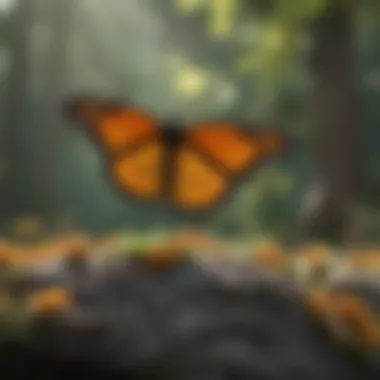

The use of pesticides in agriculture severely affects monarch butterfly populations. Pesticides not only kill harmful insects but also harm beneficial organisms, including monarchs. These chemicals can be detrimental at all stages of life, from eggs to adult butterflies. When pesticides get into the environment, they can travel beyond farms and impact nearby habitats.
Farmers can adopt integrated pest management practices and use organic farming methods to eliminate the need for harmful chemicals. This would be a positive step toward protecting the monarchs and their environments.
Increased awareness of these threats highlights the urgent need for effective conservation strategies. Protecting habitats, addressing climate change, and minimizing pesticide usage are critical for ensuring a robust future for the monarch butterfly.
Conservation Strategies for Monarch Butterflies
The conservation of monarch butterflies is crucial for maintaining their populations and ensuring that future generations can enjoy these remarkable insects. Monarchs face various threats, and it is essential to implement effective strategies to mitigate these impacts. A multi-faceted approach is necessary to address habitat loss, climate change impacts, and pesticide use. Focusing on conservation strategies helps in safeguarding these butterflies while also promoting biodiversity and ecological health in their environments.
Creating Butterfly-Friendly Habitats
Establishing butterfly-friendly habitats is one of the most impactful strategies for supporting monarch populations. This involves planting nectar-rich flowers that attract adult butterflies and providing milkweed, which is vital for monarch caterpillars. A variety of native plants can enhance local biodiversity and offer refuge for other pollinators too. Community gardens and natural reserves can serve as excellent examples of these habitats.
Here are some key considerations for creating such habitats:
- Select Native Plants: Native flowers adapt well to the local environment and require less water and maintenance.
- Ensure Continuous Bloom: Select flowers that bloom at different times throughout the seasons to offer a consistent food source.
- Avoid Pesticides: Reducing or eliminating pesticide use in these areas helps protect not only monarchs but also other beneficial insects.
Creating these habitats requires cooperation from local communities, schools, and individuals who can participate in garden initiatives or beautification projects.
Educational Outreach and Awareness
Educational outreach plays a vital role in conservation strategies for monarch butterflies. By informing the public about the importance of monarchs, we can foster a stronger connection between people and nature. Programs focused on schools, families, and local organizations can lead to increased knowledge and proactive behaviors in supporting monarchs.
Here are some effective outreach methods:
- Workshops and Presentations: These can teach people about the life cycle of monarchs and their needs for survival.
- Interactive Community Events: Events like butterfly releases or habitat planting days encourage community involvement.
- Educational Materials: Leaflets, posters, and online resources can spread information widely.
Raising awareness is not only beneficial to monarch butterflies but also enhances community appreciation for local ecosystems and encourages responsible environmental stewardship.
International Collaboration Efforts
Monarch butterflies undertake an extraordinary migration from North America to Mexico. This journey highlights the need for international collaboration in their conservation. Many countries, organizations, and researchers work together to address the challenges that cross borders, ensuring that monarch habitats and migration routes are protected.
Key elements of these international efforts include:
- Conservation Agreements: Countries can form agreements to protect critical habitats along migration routes.
- Data Sharing: By sharing research and migration data, nations can better understand monarch populations and their behavior.
- Funding and Resources: Collaborative funding initiatives can support large-scale conservation projects.
Together, these strategies create a stronger framework for monarch butterfly conservation. By harnessing the power of community action, educational outreach, and international partnerships, we can make a significant positive impact on the futures of these butterflies.
Culmination and Future Perspectives
Understanding the timeline of the monarch butterfly allows individuals to appreciate both its life cycle and the challenges these creatures face. This section highlights key elements regarding the need for continued focus on monarchs. By grasping their full journey from egg to migration, readers can comprehend the biological significance of monarch butterflies in our ecosystems.
Summary of Monarch Butterfly Timeline
The life of a monarch butterfly is rich with progression through distinct stages. Starting from the fragile egg stage, to lively caterpillars feasting on milkweed and transitioning into pupae, this transformation showcases nature's intricacies. Emphasis is placed on how these stages connect directly to survival and migration patterns. Moreover, the beautiful, vibrant adult butterflies display the culmination of adaptive evolution, enabling them to undertake long migrations.
- Egg Stage: Tiny, oval eggs are placed on milkweed plants. These eggs hatch into caterpillars.
- Caterpillar Stage: The caterpillars feed and grow, undergoing multiple molts.
- Pupal Stage: They form pupae and undergo metamorphosis, transitioning into butterflies.
- Adult Stage: Stunning butterflies are ready for migration or reproduction.
Importance of Ongoing Research
Research remains crucial to understanding the future of monarch butterflies. Scientists continue studying their migratory behavior, genetic diversity, and responses to environmental changes. Advances in technology facilitate tracking practices and habitat restoration. Research also delves into how climate change alters migratory patterns and influences food availability.
- Habitat Restoration: Scientists advocate for monarch-friendly environments to boost population numbers.
- Genetic Studies: Ongoing studies help understand adaptability and resilience.
- Public Engagement: Studies are increasingly drawing attention to citizen science, encouraging community involvement.
Empowering Future Generations
It is vital to engage young minds concerning the significance of monarch butterflies. Education can foster a sense of responsibility towards these insects and their conservation. Schools and parents can work together to create hands-on experiences that deepen understanding.
- Creating Butterfly Gardens: Encourage kids to plant native flowers that attract butterflies.
- School Projects: Introduce simple science projects focusing on butterfly life cycles.
- Awareness Campaigns: Teach the importance of biodiversity and the role of organisms like the monarch.
"Knowledge can inspire action. Understanding the intricate details surrounding monarch butterflies promotes stewardship and conservation efforts among our youth."







